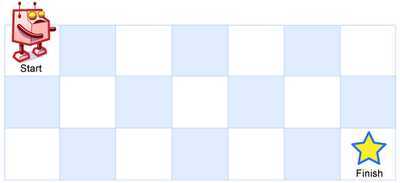Unique Paths
A robot is located at the top-left corner of a m x n grid (marked ‘Start‘ in the diagram below).
The robot can only move either down or right at any point in time. The robot is trying to reach the bottom-right corner of the grid (marked ‘Finish‘ in the diagram below).
How many possible unique paths are there?

Above is a 3 x 7 grid. How many possible unique paths are there?
Note: m and n will be at most 100.
思路:典型的动态规划,dp[i][j]表示到matrix[i][j]的路径个数,则dp[i][j] = dp[i-1][j] + dp[i][j-1]。int uniquePaths(int m, int n) {
if(m <=0 || n <= 0)return 0;
vector<vector<int> > dp(m);
int i,j;
for(i=0;i<m;i++)
{
vector<int> tmp(n,1);//至少一条
dp[i] = tmp;
}
for(i = 1;i < m;i++)
{
for(j = 1;j < n;j++)
{
dp[i][j] = dp[i-1][j] + dp[i][j-1];
}
}
return dp[m-1][n-1];
}
Follow up for "Unique Paths":
Now consider if some obstacles are added to the grids. How many unique paths would there be?
An obstacle and empty space is marked as 1 and 0 respectively
in the grid.
For example,
There is one obstacle in the middle of a 3x3 grid as illustrated below.
[ [0,0,0], [0,1,0], [0,0,0] ]
The total number of unique paths is 2.
Note: m and n will be at most 100.
class Solution {
public:
int uniquePathsWithObstacles(vector<vector<int> > &obstacleGrid) {
int rows = obstacleGrid.size();
if(rows <= 0)return 0;
int cols = obstacleGrid[0].size();
if(cols <= 0)return 0;
vector<vector<int> > dp(rows);
int i,j;
for(i = 0;i < rows;i++)
{
vector<int> tmp(cols);
dp[i] = tmp;
}
dp[0][0] = obstacleGrid[0][0] == 0 ? 1 : 0;
for(i = 1;i < rows;i++)dp[i][0] = obstacleGrid[i][0] == 0 ? dp[i-1][0] : 0;//当为0时,不能简单的初始化为1,要初始化为前面的值,因为可能被前面挡住了
for(j = 1;j < cols;j++)dp[0][j] = obstacleGrid[0][j] == 0 ? dp[0][j-1] : 0;
for(i = 1;i < rows;i++)
{
for(j = 1;j < cols;j++)
{
dp[i][j] = obstacleGrid[i][j] == 0 ? dp[i-1][j] + dp[i][j-1] : 0;
}
}
return dp[rows-1][cols-1];
}
};原文地址:http://blog.csdn.net/fangjian1204/article/details/38872155